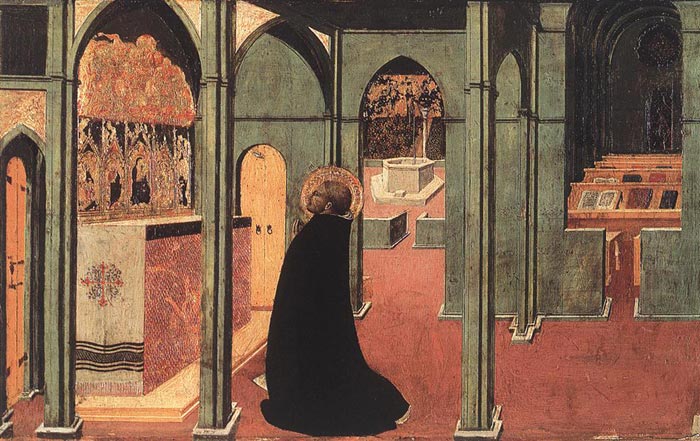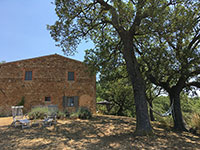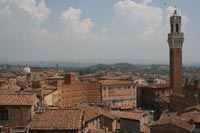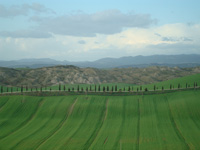| |
|
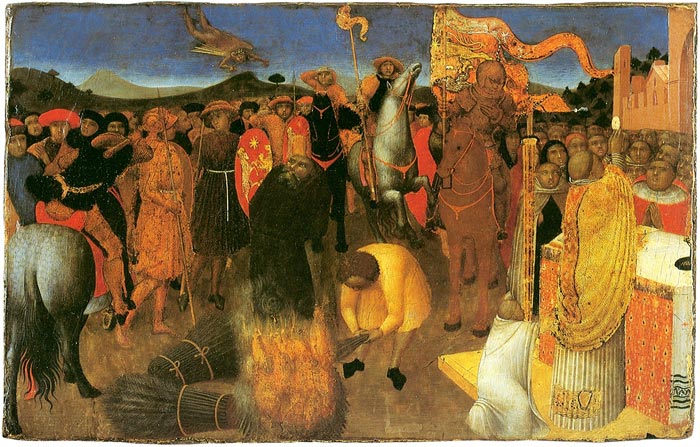 |
Sassetta, Death of the Heretic on the Bonfire; 1423, National Gallery of Victoria, Melbourne.
The picture shows one of the predella paintings of the Altar of the Eucharist.
|
The Lana Altarpiece, the first known work by Sassetta, was commissioned by the "Arte della Lana", i.e. the woolmerchants' guild for the church of the Carmelite Order in Siena in 1423. It was made for the feast of Corpus Christi. It upheld the doctrine of transubstantiation according to which bread and wine is changed at the Eucharist into the actual Body and Blood of Christ.
Pietro Torriti does not fail to point out the exceptional nature of the work and to underline that between 1423 and 1426, Sassetta must be considered "the most modern painter in Europe": in fact, in the same period, that is, before 1423, we do not know of any work by Masaccio or Fra Angelico , the only ones who could have rivaled him in the field of spatial representation and the illusion of depth that it is possible to create, in painting, on a flat support.
Pietro Torriti :
«The artist's first major commission, The Lana Altarpiece, is a "work of exceptional importance for all Sienese painting of the Quattrocento, and of exceptional beauty, as attested by the various fragments preserved, where the very first revolutionary innovations of the Renaissance are already visible, both in terms of the perspective of the architectures, which are no longer Gothic, and for the important search for naturalism in the various figures and in the landscapes with crystalline skies whose color gradually fades towards the horizon. This is particularly evident in the stories of the predella that have fortunately come down to us, although they are only fragments.»
The triptych was dissembled in 1777, and the central panel is lost, but it is possible to reconstruct its original arrangement from earlier descriptions. According to these, the central panel represented the Holy Sacrament in an ostensory adored by a number of angels around it. Above this there was the scene of the Coronation of the Virgin, and on the sides Abbot S. Anthony and S. Thomas Aquinas were depicted. Above these the scene of the Annunciation was represented in two separate pictures.
On the predella underneath the main panel, seven small panels showed the following scenes: 1-2. Two scenes from the life of S. Anthony, one of them is about his temptation (Siena, Pinacoteca); 3. Execution of an Heretic on the Bonfire (Melbourne Museum); 4. The Last Supper (Siena, Pinacoteca); 5. The Miracle of the Holy Sacrament (Barnard Castle, Bowes Museum); 6. S. Thomas Aquinas in Prayer in front of the Altar of the Virgin (Budapest, Museum of Fine Arts); 7. S. Thomas Aquinas in Prayer in front of the Crucifix (Vatican, Pinacoteca).
Further to the above mentioned ones we know eight panels from the external pillars that represented the Four Doctors of the Church: S. Jerome, Gregory, Ambrose, Augustine as well as the four patron saints of Siena: S. Ansanus, Victor, Savinus and Crescentius. Two small panels from the pinnacles with the figures of the Prophets Elias and Eliseus still exist in the Sienese Picture Gallery. Under the central panel the following inscription was visible: "Hinc opus omne Patres Stefanus construxit ad aras Senensis Johannis agens citra lapsus adultos". The interpretation of this distych is much debated.
The iconographic programme of the altar was probably composed by the Carmelite monks. That is why the two prophets, Elias and Eliseus, the "Dux et Pater" and the Pater of the Carmelites were represented on the altar, and in Carmelite habit. We can also see a few Carmelite monks in the pictures of the predella.
|
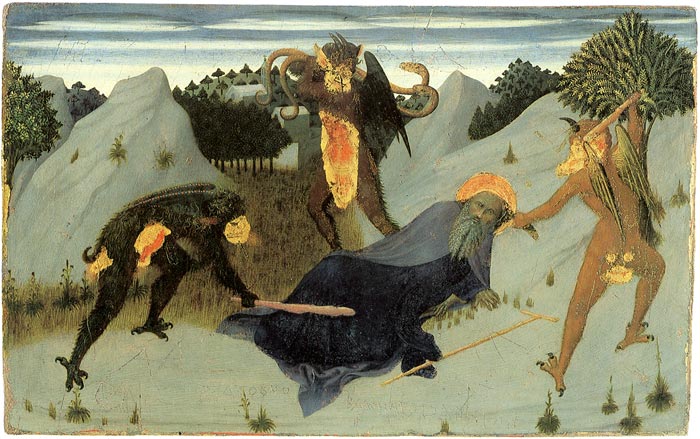 |
Sassetta, Saint Antony Beaten by the Devils, Siena, Pinacoteca Nazionale
|
In the St. Antony Beaten by Devils, one of the panels of the predella, the depth and articulation of the landscape is for the flrst time seen against a blue sky sueaked witb white douds, instead of the customary gold background. In the Adoration of the Magi in the Chigi Saracini Collection in Siena, a fragment of a larger composition which included the Journey of the Magi in the Griggs Collection in New York, we clearly see that Sassetta was greatly attracted by the art of Gentile da Fabriano, who spent some time in Siena in 1425 and 1426. But it is with the great altar-frontal of the Madonna della Neve, painted in 1430-32 for the Cathedral of Siena and now in the Contini Bonacossi Foundation (Uffizi), that he clearly shows how far he adhered to the "great Florentine concepts of form in perspective" (Graziani), even if these do not have much effect on the composition, but. rather tend to stimulate occasional brilliant innovations.
|
 |
Sasetta, , The Last Supper, 1423, Panel, 24 x 38 cm, Pinacoteca Nazionale, Siena
|
| |

|
Sasetta, The Vision of Saint Thomas Aquinas (St Thomas Before the Cross), 1423, Panel, 25 x 28,8 cm, Pinacoteca, Vatican
|
| |
|
|
|
|
| |
|
|
|
|
| The life of St Thomas Aquinas was not full of spectacular miracles, and so the painter of this panel had to illustrate a subject that was not thankful from an artistic point of view. He showed the Saint deeply absorbed in prayer. God the Father, appearing in a circle of angels, send the Holy Ghost to him, in the shape of a dove. The Saint is kneeling almost gracefully, though completetly without movement, and around him there is the view of a spacious church interior, and the library and courtyard of a monastery. The sequence of spatial layers is used in such a way as to add to the animation of the composition. |
|
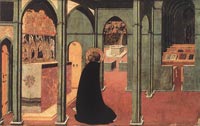
St Thomas Inspired by the Dove of the Holy Ghost, 1423, Szépmûvészeti Múzeum, Budapest
|
These two small panels in Siena's Pinacoteca nazionale have long been considered among the earliest examples of landscape painting in Europe and have long been attributed to Ambrogio Lorenzetti. Today, art historians assume they were part of the Arte della Lana tryptic painted by Sassetta.
|
| |
|
 |
|
 |
| |
|
Sassetta, Città sul mare (veduta di Talamone), (1340 circa), Siena, Pinacoteca, precedentemente attribuita ad Ambrogio Lorenzetti |
|
Stefano di Giovanni di Consolo da Cortona (Sassetta), Paesaggio con castello in riva al lago, Siena, Pinacoteca, precedentemente attribuita ad Ambrogio Lorenzetti |
Federico Zeri proposed to identify the panels that belonged to the polyptych of the Arte della Lana, by integrating in particular into the whole the two small landscapes ( Una città sul mare "; Un castello in riva al mare . Pinacoteca Nazionale di Siena) today attributed to Sassetta (after having long been considered to be by Ambrogio Lorenzetti...), even if their integration into the work still raises many questions linked in particular to their location, their format and their meaning in this context.[4] |

[1] Sassetta (ca. 1400-1450), the greatest painter of the Sienese school in the 15th century, is noted for the gentle piety of his art.
The place and date of birth of Stefano di Giovanni, known as Sassetta are unknown. He may have been born in Cortona, the home of his father, Giovanni di Consolo. A baptismal record preserved in Siena dated Dec. 31, 1392, for one Stefano di Giovanni is widely accepted as evidence that he was born in Siena that year. Some scholars, however, would suggest a birth date not before 1400 on the basis of Sassetta's earliest dated work of 1423.
Sassetta's style was wholly Sienese in character, suggesting that he was trained in the shop of some Sienese master. Whether or not that master was Paolo di Giovanni Fei, as suggested by some critics, is unknown. In 1440 Sassetta married Gabriella di Buccio di Biancardo. The eldest of their three children was the sculptor Giovanni di Stefano. Sassetta died in April 1450, after contracting pneumonia the previous month while frescoing the Porta Romana, Siena.
On July 1, 1423, the wool guild (Arte della Lana) commissioned an altarpiece (now disassembled) from Sassetta for its chapel next to the church of S. Pellegrino, Siena. From 1426 to 1431 he was associated with the Cathedral Works, Siena. Among the documents from this period are records of payment dated December 1427 for a drawing of the baptismal font "in the shape that it ought to take." This suggests that he may have collaborated with Jacopo della Quercia, the sculptor who built the font.
On March 25, 1430, Sassetta was commissioned to paint an altarpiece of the Madonna with Saints with the legend of the founding of S. Maria Maggiore, Rome, in the predella. The Madonna of the Snow, as it is called, was finished by mid-October 1432. His style in this work betrays the influence of Masaccio, especially in the broad modeling of the Virgin and Child and in the arrangement of figures in the predella. Little is known of Sassetta's activities between 1433 and 1436, though this is the period when he probably painted the Crucifixion for S. Martino (of which fragments remain) and the altarpiece for S. Domenico, Cortona.
The altarpiece of the Madonna with Saints Jerome and Ambrose, dated 1436, in the Church of the Osservanza, Siena, formerly attributed to Sassetta, is now generally attributed to another artist, the so-called Osservanza Master. Some critics would extend the oeuvre of the Osservanza Master to include the Birth of the Virgin in Asciano and the group of panels with the life of St. Anthony Abbot from an altarpiece dedicated to the saint. These panels still have advocates who attribute them to Sassetta.
Two small panels, the Journey of the Magi and the Adoration of the Magi, were probably once part of a single composition. The most important extant later work by Sassetta is the altarpiece (now dismembered) commissioned on Sept. 5, 1437, and completed by June 5, 1441, for the church of S. Francesco, Borgo San Sepolcro. His style in these panels is somewhat flatter and more decorative than in the Madonna of the Snow. When Sassetta died, he left at least two major works unfinished: the fresco decoration of the Porta Romana, Siena, and the Assumption of the Virgin.
[2] Arte della Lana : Guild or Guild of Arts and Crafts that brought together all the trades that produced or processed wool. It was for a certain period one of the most powerful and richest of its time. It is also the only guild in Siena that maintained its autonomy throughout its existence. [Machtelt ISRAELS , “Altari della strada: la corporazione della lana, i Carmelitani e la festa del Corpus Domini a Siena (1356 –1456)”, Studi sul Rinascimento , XX (2006)?
[3] Pietro TORRITI, La Pinacoteca di Siena . I dipinti dal XII al XV secolo , Genova, Monte dei Paschi di Siena, 1977, p. 240. Also mentioned on ; Guide artistique de la Province de Sienne | www.provincedesienne.com
[4] Federico ZERI, « Towards a Reconstruction of Sassetta’s Arte Della Lana Triptych (1423-6) », The Burlington Magazine, vol. 98, no. 635, 1956, pp. 36–41.
|

Art in Tuscany | Sassetta
Art in Tuscany | Sassetta | San Sepolcro Altarpiece
Koichi Toyama, Light and Shadow in Sassetta: The Stigmatization of Saint Francis and the Sermons of Bernardino da Siena
How Maru and Bernard Berenson rediscovered Sassetta's Altarpiece
|
|
|
